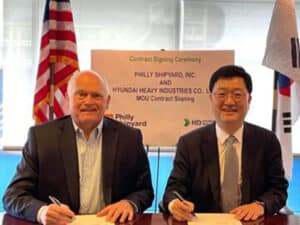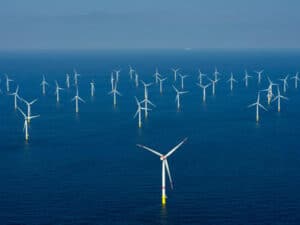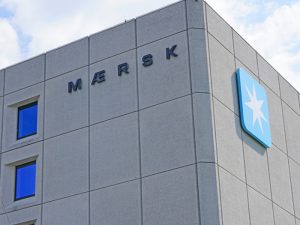
OSG: The year starts well
Written by Nick Blenkey
OSG president and CEO Sam Norton: “Transporting liquified CO2 is a natural next step into an exciting emerging market, consistent with OSG’s expertise with liquid cargoes.“
“The year has started well at OSG,” said president and CEO Sam Norton, as Tampa, Fla. headquartered tanker and ATB operator Overseas Shipholding Group, Inc. (NYSE: OSG) reported results for the first quarter of 2023. “All asset categories achieved financial results at or above expectations. For the third consecutive quarter, we delivered adjusted EBITDA in excess of $40 million, despite having three fewer operating vessels during the first quarter of 2023 as compared to the final two quarters of 2022. Above average lightering volumes and the continued strength in international MR markets, as well as incrementally higher average TCE rates for our Jones Act MR tankers, all contributed to the past quarter’s favorable results. The stability of cash flow witnessed in the past several quarters has allowed cash balances, including investments in treasury securities, to increase to $118.9 million at quarter end.”
“In April,” continued Norton, “OSG signed operating agreements with MARAD for our three internationally trading U.S. flag vessels to enter into the Tanker Security Program. These contracts are the result of many years of work with labor, industry, and government partners to stand up this important program. OSG is proud to have the first ships to be entered into this program and looks forward to further growth opportunities for its internationally trading U.S.- flag tankers, both in the context of the Tanker Security Program as well as in other supporting roles tied to our national security.”
RESULTS
Shipping revenues were $113.8 million for the first quarter of 2023, an increase of $9.8 million, or 9.4%, compared to the first quarter of 2022. TCE revenues were $104.7 million for the first quarter of 2023, an increase of $10.8 million, or 11.5%, from the first quarter of 2022. The increases primarily resulted from a 255-day decrease in layup days. There were no vessels in layup during the first quarter of 2023. During the first quarter of 2022, there were two vessels in layup for the full quarter and two additional vessels that came out of layup during that quarter. Additionally, the increase in revenues resulted from (a) an increase in average daily rates earned by our fleet, (b) a 27-day decrease in drydock days, (c) an increase in Delaware Bay lightering volumes and (d) one full Government of Israel voyage and one partial Government of Israel voyage that began during the first quarter of 2023 but was completed in the second quarter during the three months ended March 31, 2023 compared to one full voyage during the same period in 2022. The increase was partially offset by fewer vessels in our fleet as we returned three conventional tankers leased from American Shipping Company in December 2022.
Operating income for the first quarter of 2023 was $22.5 million compared to operating income of $7.7 million for the first quarter of 2022. Net income for the first quarter of 2023 was $12.1 million, or $0.14 per diluted share, compared with a net loss of $509 thousand, or $(0.01) per diluted share, for the first quarter of 2022.
Adjusted EBITDA was $40.9 million for the 2023 first quarter, an increase of $15.5 million compared with the first quarter of 2022, driven primarily by the increase in TCE revenues.
CONFERENCE CALL
In a conference call with financial analysts, Norton said that, in the first quarter, “the primary takeaway is that much has gone as planned.”
“This is largely as expected with such a significant portion of our vessels operating under fixed time charter contracts. To the extent that variability to expectations will materialize during the coming year, these will occur as a result of changes in lightering volumes and in the rate conditions experienced in the international MR market in which our non-Jones Act vessels trade,” he said. “As noted earlier, we saw a better than expected performance in both of these areas during the first quarter, which helped get the year off to a good start. Improved market conditions have provided opportunities to reduce exposure to volatility in our conventional tanker trades and given us a forward book of contract cover that extends for several years.”
However, he noted that a number of factors have caused the company to be cautious about annualizing its first quarter results for the balance of the year.
“First, we expect the over-performance seen in lightering and international MRs to revert on average to more normalized levels over the balance of the year. Should this occur, we would expect TCE contributions from these assets to drop on a quarterly basis by approximately $5 million.
“Second, we will have a heavier schedule for intermediate surveys and drydocks over the balance of the year with nine out of service periods planned versus two in the first quarter. Days not earning will thus rise during the balance of the year as compared with the first quarter. Nonetheless, our forecast for the full-year 2023 does not change from our views presented two months ago.
“We continue to see time charter equivalent earnings for the full-year approaching $400 million. Attaining this top line result should generate adjusted EBITDA between a 140 million and 150 million for the full calendar year 2023. After deducting debt servicing plan, maintenance capital expenses, we anticipate that free cash flow for the full-year should be between $50 million and $60 million.
“To deliver these results, our mission is firmly focused on execution and operational excellence, as well as the pursuit of growth opportunities in our specialized businesses. As we have stated in prior calls, the use of surplus cash flow is a regular topic of conversation with our board.
“We consider allocation of capital decisions to be among the most important we must make towards achieving a proper balance between investing in the future, managing the level of our fixed payment obligations, and considering appropriate means for returning cash to our shareholders.
TRANSITION TO ZERO-EMISSIONS
“We recognize the need to invest in solutions to ensure the long-term sustainability of our business model and to be responsive to ambitious goals of achieving a future target of [zero emissions] for ocean shipping. Succeeding these efforts will require consensus on viable technology and practical solutions to apply across the entire supply chain of production and distribution, large capital investments with extended payback periods and scale development of effective and widely available alternatives to fossil fuels.
“During this transition, there will be a continued need for transporting conventional fuels and for investing in existing tankers to improve performance and to reduce greenhouse gas emissions as our industry evolves. OSG is committed to reducing its carbon emissions and has set its own specific targets. Incremental and continual improvement are our goals. We will meet these targets in the short run by improving our operational efficiencies.
“In the medium-term, we are using and participating in the supply chain for alternative fuels and testing technologies for investment to retrofit existing ships. In the longer-term, we are partnering with others to invest in and develop technology and processes necessary to make meaningful reductions to carbon emissions.
“We are also exploring new opportunities for transporting liquid bulk commodities other than fossil fuels. These evolving markets point to interesting and exciting potential for OSG to leverage its strong operating franchise. OSC continued to commit resources to identify the best opportunities available. With this vision, we will remain true to our mission of being a world-class shipper of liquid bulk commodities.”




